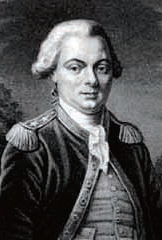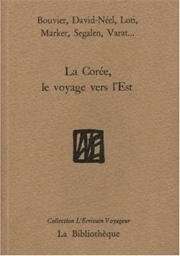NORTHEAST ASIAN HISTORY FOUNDATION 07/2013
-
Written by Lee Sang-gyun, Research Fellow at Dokdo Research Institute
 French Explorer La Pérouse
French Explorer La PérouseEditor's Note: How did Europeans observe and experience Korea from the 1700s through the early 1900s? This question might be answered in La Corée, le voyage vers l'Est (Korea, a Voyage to the East), a recently published French book, which is reviewed in detail in this essay.
Pre-Modern Europeans' Perception of Korea and Discovery of Ulleungdo/Dokdo
In 1635, with the wreck he Dutch vessel Sparrow-hawk in the sea off Jeju Island, this Korean island became known to Europeans for the first time. Years later, in 1653, Hendrik Hamel's vessel of the Dutch East India Company was also wrecked on the coast of Jeju Island. There were 36 survivors, but they were detained in Korea (Joseon) until thirteen years later, when Hamel and his seven men escaped to Nagasaki, Japan. Hamel's journal, published in 1668, remained the only Western account of Korea for over two centuries.
Once Korea became known to the West in earnest, the French explorer La Pérouse approached this island (Jeju Island, ile Quelpaert) on May 21, 1787. La Pérouse observed its appearance and farmland while circling the island for days before he continued his north-bound voyage through the Korean Strait and along the east coast of Korea. On the 27th day of the same month, they became the first Europeans to discover Ulleungdo. According to La Pérouse, no Western country at that time had maps marked with Ulleungdo. La Pérouse named this island Dagelet, and wrote: "This island is about 100 kilometers away from the coast of Korea, and about 15 kilometers in circumference, and has a lot of really beautiful trees". They intended to approach the inhabitants of this island and let them know that they were no enemies (ennemi), but their ship was turned away from the island due to rough seas. Anyway, this was how Ulleungdo became known to the West. Dokdo was discovered about sixty years after this, in 1849, by the French whaler Liancourt. And this was how Dokdo became known to the West and associated with the name Rochers Liancourt.
* From the fact that Ulleundo is actually about 130 kilometers away from the east coast. we can see that La Pérouse's estimate was not accurate but close enough. And the road today running along the edge of Ulleungdo is about 52 kilometers in length. Even though La Pérouse's estimate is far off from the actual length, it is still interesting that he made such an estimate without landing the island.
How the Book Is Organized and About the Authors
 Cover of Korea,
Cover of Korea,a Voyage to the East
While geographic information about Korea may have been passed to the West by way of China or Japan, this book is significant as the first-hand account of Europeans who either sailed the seas near Korea or actually visited Korea and wrote about their observations of the country from various perspectives. This book is a collection of relatively short essays about Korea written by multiple authors from the mid-1700s to the early 1900s. The professions of the authors were varied, ranging from an explorer to a naval officer, a technician, an interpreter, an Orientalist, a Far East expert, a journalist (correspondent), a writer, a journal founder and editor, a traveller, a naval surgeon, a priest, a photographer, a Royal Geography Society member, and a diplomat. Their activities show how much France was interested in the Far East during the 18th century, from the age of exploration to the age of imperialism.
This book was published in 2007 by the French publisher La Bibliothèque, and its key author is Alexandra Néel. It consists of seven parts in total. The editor gives a summary of this book in the introduction ('In the Land of Morning Calm'), and mini-biographies of the authors at the end. The seven main topics and their sub-topics are as follows: Approaching Korea (Do Not Approach the Coast of Korea, The First Exploration of Korea); In Seoul (Poor Yet Generous Korea, A Rainy Day, The Large Bell Tower, A Visit to the Palace); Scenery (Mountain God, At a Temple in Mt. Geumgang); About Markets (Markets in Seoul, A Visit to a Market in Seoul); Books, Paper, and Printshops (Travelling Korea, Books and Publishers, A Few Korean Books, Korea of Dreams); Yangban (noblemen) (The Murdered Poet, The Most Arrogant Class in the World, A Frickle Politician, Class for High-Ranking Officials, Farting Yangban); Korean Women (Leaves in the Sunshine, Mrs. Uhm, Vixens, A Dancer And A Diplomat). The authors observed various aspects of Korea from interesting viewpoints and described their observations in detail.
Valuable Historical Record for Studies of Pre-Modern Far East and Korea
This book, a detailed description of Korea's territory, scenery, society, and culture as observed by Westerners, specifically Frenchmen, in their expansion to the Far East during pre-modern times, is a valuable resource that shows the interest of Westerners at the time in the Far East (Korea). This book also offers a glimpse into France's Korea policy at the time, and seems to have value as a primary historical record for the study of Ulleungdo and Dokdo. I hope that this book will be translated into Korean soon, and that other similar books and documentation in other countries will be also introduced to Korea.


